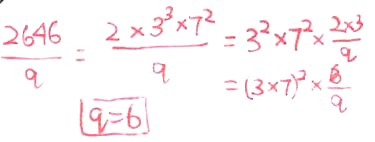Eric Nicholas K's answer to heykbye's Secondary 1 Maths Singapore question.
done
{{ upvoteCount }} Upvotes
clear
{{ downvoteCount * -1 }} Downvotes
To solve such questions, we need to realise that the powers of each prime number must be divisible by 2 for the expression to be a perfect square. Similarly, the powers of each prime number must be divisible by 3 for the expression to be a perfect cube.
Here, 2 has a power of 1, which is not a multiple of 2, so we have to 'remove' it. Similarly, 3 has a power of 3 which is not a multiple of 2, so we have to remove at least one 3. However, 7 has a power of 2 which is obviously a multiple of 2, so we do not need to remove any 7.
Thus, the smallest possible number to be removed (in the form of q) is 2 x 3 = 6.
Here, 2 has a power of 1, which is not a multiple of 2, so we have to 'remove' it. Similarly, 3 has a power of 3 which is not a multiple of 2, so we have to remove at least one 3. However, 7 has a power of 2 which is obviously a multiple of 2, so we do not need to remove any 7.
Thus, the smallest possible number to be removed (in the form of q) is 2 x 3 = 6.
Date Posted:
5 years ago


